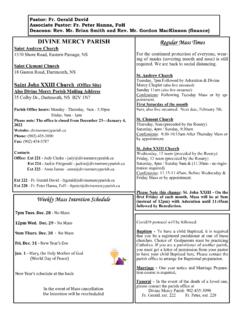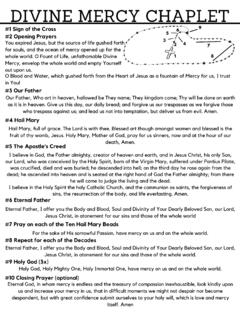Transcription of Penitential Act, Form 3 - Roman Catholic Diocese of ...
1 Penitential Act, Form 3 page 1 of 11. Penitential Act, Form 3 _____ Penitential Act has four parts. The Roman Missal, Third Edition, provides three forms for the Penitential Act within the Introductory Rites for Mass. All three forms follow the same four-part pattern: (1) invitation to the faithful by the Priest, (2) a pause for silence, (3) the prayer, and (4) the absolution by the Priest. Form 3 texts found in two places. As is the pattern with the new translation rules of Liturgiam Autheniticam: Fifth Instruction for the Right Implementation of the Constitution on the Sacred Liturgy of the Second Vatican Council (2001), the additional sample invocations for the Penitential Act form 3 are only found in Appendix VI for the Diocese of the United States. Form 3 may be freely composed. Although the Missal provides patterns for form 3, the first in the Order of Mass and the remaining seven samples in Appendix VI, the rubrics permit local composition.
2 This allows the local community to invoke the Risen Christ in particular ways suited to the day, the season, and the needs of those who gather on a given day for prayer. This litany, however, is not like an examination of conscience for sacramental Penance. It is not a listing of specific sins. It is always acclamation to Christ who is full of mercy. So, don t get in a rut. Use the freedom that the Missal provides. Carefully choose from the examples of the Missal a text to suit the occasion. Carefully write other invocations to suit local need. Who is the minister of the tropes for form 3? It does not belong to the Deacon as does the Gospel, the Prayer of the Faithful, and the Dismissal. The rubric reads: The Priest, or a Deacon or another minister, then says the following or other invocations * with Kyrie, eleison (Lord, have mercy). It may also be sung. The Mass and Its Parts Navigating the Roman Missal The pastoral effectiveness of a celebration will be greatly increased if the texts of the readings, the prayers, and the liturgical chants correspond as aptly as possible to the needs, the preparation, and the culture of the participants.
3 GIRM, no. 352. Diocese of Springfield in Illinois Office for Worship and the Catechumenate 1615 W. Washington St. Springfield IL 62702-4757 (217) 698-8500 Eliot Kapitan, 28 November 2016 Penitential Act, Form 3 page 2 of 11. Resources to Consult General Instruction of the Roman Missal [GIRM], nos. 51-52 on the general structure, the option of the blessing and sprinkling of water, and the use of Lord, have mercy . Note: GIRM Chapter IV, The Different Forms of Celebrating Mass is silent on who sings or recites the tropes of form 3. Introduction to the Order of Mass: A Pastoral Resource of the Bishops Committee on the Liturgy (2003), nos. 71-73 treats the concerns raised in GIRM, no. 51; addresses forms 1 and 2; addresses the Kyrie but is silent on form 3. Sing to the Lord: Music in divine Worship (2007), nos. 145-146 particularly addressing form 3 and the Kyrie. Paul Turner. Let Us Pray: A Guide to the Rubrics of Sunday Mass, revised.
4 Collegeville: Liturgical Press, 2012. Nos. 212-226 on the invitation by the priest, on silence, on each of the three forms. No. 219 notes the samples in Appendix VI, others may be freely composed, however, they should be acclamations to Christ who is merciful, not a litany of sins for which the faithful seek mercy. _____ Texts from the Roman Missal Excerpts from The Roman Missal 2010, International Commission on English in the Liturgy Corporation. All rights reserved. Penitential Act Third Form Penitential Act, Form 3 page 3 of 11. Penitential Act, Form 3 page 4 of 11. Penitential Act, Form 3 page 5 of 11. Penitential Act, Form 3 page 6 of 11. Penitential Act, Form 3 page 7 of 11. Penitential Act, Form 3 page 8 of 11. Penitential Act, Form 3 page 9 of 11. Penitential Act, Form 3 page 10 of 11. Penitential Act, Form 3 page 11 of 11.
![S C B [USCCB] Committee on Divine Worship [CDW]. …](/cache/preview/a/2/9/f/c/5/a/4/thumb-a29fc5a4c1574c7cda908606fb713a77.jpg)














